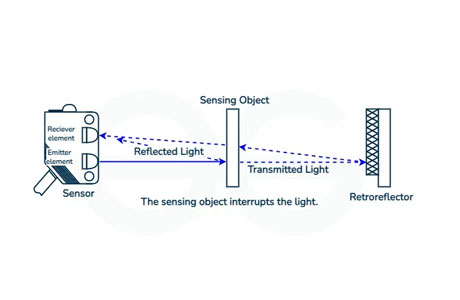Key Takeaway
Through-beam photoelectric sensors work by having a separate emitter and receiver. The emitter sends a light beam, and the receiver detects it. When an object interrupts the beam, the sensor triggers a response. These sensors are highly reliable for detecting small objects or precise locations.
Through-beam sensors are commonly used in industrial applications like detecting parts on conveyor belts or ensuring safety in machinery. They provide long-range detection and are effective in dusty or challenging environments, making them ideal for many industries.
The Working Principle of Through-Beam Photoelectric Sensors
The basic operation of a through-beam sensor is quite straightforward. The transmitter and receiver are positioned opposite each other, with the light beam connecting the two. The sensor remains in a stable state as long as the beam is unbroken. However, when an object interrupts the light, the receiver detects the change, and the system triggers a response, such as halting a machine or counting an item. This design minimizes the chances of false detections, making it ideal for high-speed and precision-based processes in manufacturing.

Key Advantages of Through-Beam Sensors in Industrial Applications
Through-beam sensors are vital in industrial settings due to their long sensing range and resistance to interference. Unlike other sensors, they can detect objects several meters away, making them ideal for large-scale operations like automated factories or material handling systems. Their powerful light beam cuts through environmental obstructions like dust or fog, ensuring consistent and reliable detection. This resilience against environmental interference makes them highly efficient in diverse industrial applications.
Additionally, through-beam sensors provide accurate detection, even over long distances. This accuracy reduces false readings and improves operational efficiency by preventing unnecessary system halts. Their durability means fewer malfunctions or breakdowns, lowering downtime and maintenance costs. This combination of long-range, reliability, and resilience makes through-beam sensors an excellent choice for high-demand industrial environments.
Common Uses for Through-Beam Sensors in Various Industries
Through-beam sensors are found in various industries due to their versatility. In manufacturing, they help count items on assembly lines, detect small objects, and confirm product positioning. Their precision makes them indispensable in processes where even the smallest error can disrupt operations. These sensors are widely used in automated systems, ensuring that production remains efficient and consistent.
In logistics and warehousing, through-beam sensors are essential for inventory management and object detection in conveyor systems. Their adaptability across industries like automotive, packaging, and logistics is a testament to their flexibility and reliability. These industries rely on the high accuracy and efficiency that through-beam sensors deliver, especially in environments where precise detection is crucial.
Installation and Setup Best Practices for Through-Beam Sensors
When installing through-beam sensors, ensuring correct alignment between the transmitter and receiver is critical. Misalignment can lead to inaccurate detection, resulting in operational delays. To prevent this, take time to carefully align both components during setup. It’s also important to place the sensors in clean, accessible areas, which allows for easier maintenance and cleaning. This prevents issues caused by dust or dirt on the sensor lenses.
Additionally, the installation should consider shielding the sensors from interference, such as strong ambient light or reflective surfaces that could distort the beam. Regular calibration during setup ensures long-term accuracy. Following the manufacturer’s guidelines for wiring and connection is essential to avoid technical issues. These best practices ensure the sensors function optimally, reducing the risk of errors in the detection process.
How to Maintain and Troubleshoot Through-Beam Photoelectric Sensors
Maintenance is key to maximizing the lifespan and efficiency of through-beam sensors. Dust or debris can accumulate on the sensor lenses, leading to false detections or a decrease in performance. A simple yet effective solution is to clean the lenses regularly with a soft cloth, which can prevent many common issues. Regular inspections should also include checking for alignment shifts caused by external vibrations or impacts.
If the sensor is not performing as expected, the first step is to verify the alignment between the transmitter and receiver. Loose wiring is another common problem, so it’s important to inspect all connections regularly. By following these simple troubleshooting steps, you can prevent most problems and ensure the sensor continues operating at peak performance.
Conclusion
Through-beam photoelectric sensors play a crucial role in industrial automation. Their high accuracy, durability, and adaptability make them indispensable in industries that demand precise object detection and distance measurement. Whether in manufacturing, packaging, or logistics, these sensors help streamline operations, reduce downtime, and improve efficiency. By understanding their working principle, installation, and maintenance, companies can ensure that their systems run smoothly and efficiently. Through-beam sensors are not just tools—they’re integral to modern industrial processes, helping industries meet their production goals with precision and reliability.
